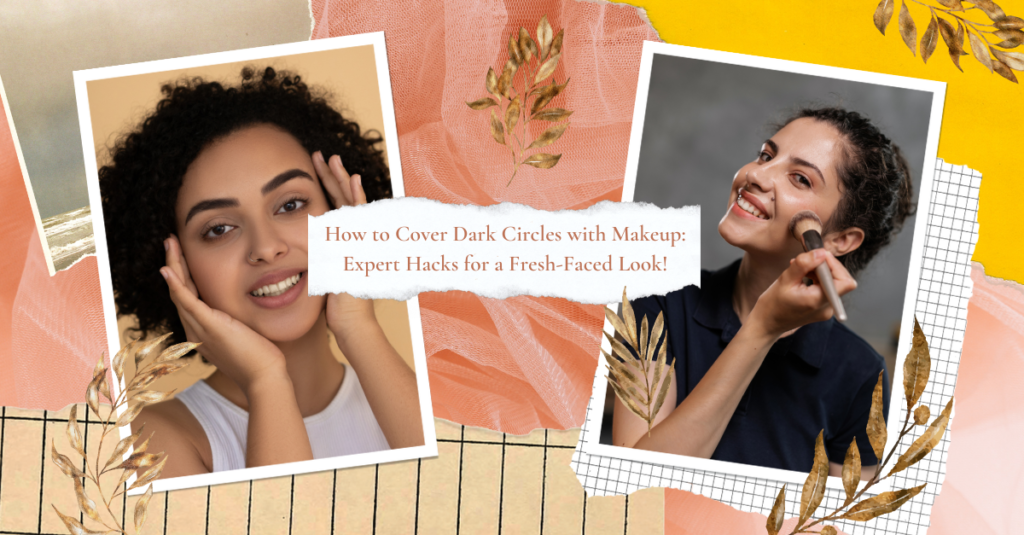In this article, we will share expert hacks for covering dark circles with makeup. We’ll explore the different types of products and tools you can use, including color correctors, concealers, and setting powders. We’ll also discuss tips for choosing the right shades and formulas to match your skin tone and skin type. Additionally, we’ll provide step-by-step instructions for applying makeup to cover dark circles, including techniques for blending and setting the products for long-lasting wear.
Types of Dark Circles
Before we dive into makeup techniques for covering dark circles, it’s important to understand the different types of dark circles that exist. This knowledge will help you choose the right products and techniques to address your specific concerns.
- Pigmentation: This type of dark circle is caused by an increase in melanin production in the skin, resulting in a darker pigmentation around the eye area. Pigmentation is often more common in people with darker skin tones.
- Hollows: Hollows are caused by a loss of fat and collagen in the under-eye area, which can create a shadow effect that makes the area appear darker. This type of dark circle is more common in people who are older or who have thinner skin.
- Puffy Eyes: Puffy eyes are often caused by fluid retention or swelling around the eye area. They can make the under-eye area appear darker due to the shadow effect created by the swelling.
- Allergies: Allergies can cause dark circles due to inflammation and swelling in the under-eye area.
Once you understand the type of dark circles you have, you can choose the right products and techniques to address them.
Color Correctors
Color correctors are an essential tool for covering dark circles, particularly those caused by pigmentation or allergies. These products work by neutralizing the color of the dark circles, creating a more even base for your concealer.
When it comes to color correctors, the general rule is to use a color opposite to the one you want to neutralize. For example, if you have dark circles with a blue or purple undertone, you’ll want to use a yellow or peach-toned color corrector to neutralize them. If your dark circles have a green undertone (common in allergies), you’ll want to use a pink-toned color corrector.
Here are some color corrector options to consider:
- Peach-toned color correctors: Peach-toned color correctors work well for neutralizing blue or purple undertones in dark circles. They work particularly well for people with fair to medium skin tones. Try the Becca Under Eye Brightening Corrector or the Maybelline Instant Age Rewind Eraser Dark Circles Treatment Concealer.
- Yellow-toned color correctors: Yellow-toned color correctors work well for neutralizing purple or blue undertones in dark circles, particularly for people with medium to deep skin tones. Try the NYX Professional Makeup Dark Circle Concealer or the LA Girl Pro Conceal HD Concealer.
- Pink-toned color correctors: Pink-toned color correctors work well for neutralizing green undertones in dark circles, which can be caused by allergies. They work well for people with fair to medium skin tones. Try the Yves Saint Laurent Touche Eclat Neutralizer or the L’Oreal Paris True Match Color Correcting Crayons.
Application Tips for Color Correctors
To apply color correctors, use a small, dense brush or your finger to gently pat the product onto the dark circles. Be sure to blend the edges of the product seamlessly into your skin to avoid any harsh lines. Once you’ve applied your color corrector, follow up with your regular concealer and foundation routine.
Concealers
Concealers are an essential tool for covering dark circles. They work by providing coverage to the under-eye area, creating a brighter, more even-toned appearance. When choosing a concealer for dark circles, look for a formula that is lightweight, but still provides full coverage. You’ll also want to choose a shade that matches your skin tone or is slightly lighter, as using a shade that is too dark can actually make dark circles more prominent.
Here are some concealer options to consider:
- Liquid Concealers: Liquid concealers are a popular choice for covering dark circles, as they are lightweight and blend easily into the skin. Try the Nars Radiant Creamy Concealer or the Maybelline Instant Age Rewind Eraser Dark Circles Treatment Concealer.
- Stick Concealers: Stick concealers are another option for covering dark circles, and they are great for people who prefer a more matte finish. Try the Tarte Shape Tape Concealer or the Bobbi Brown Creamy Concealer.
- Cream Concealers: Cream concealers provide a thicker, more opaque coverage than liquid or stick concealers. They work well for people with dry or mature skin. Try the Laura Mercier Secret Camouflage Concealer or the Kevyn Aucoin Sensual Skin Enhancer.
Application Tips for Concealers
To apply concealer to cover dark circles, start by applying a small amount of product to the under-eye area using a small, flat brush or your finger. Use a gentle tapping motion to blend the product into your skin, making sure to blend the edges of the product seamlessly. If you need additional coverage, you can apply another layer of concealer, being careful not to apply too much product, which can create a cakey appearance. Once you’ve applied your concealer, follow up with your regular foundation routine.
Setting Powders
Setting powders are an essential tool for ensuring that your concealer and color corrector stay in place all day. They work by absorbing excess oil and setting the makeup, creating a long-lasting finish. When choosing a setting powder for under-eye concealer, look for a formula that is finely milled and translucent to avoid any cakiness or creasing.
Here are some setting powder options to consider:
- Laura Mercier Translucent Loose Setting Powder: This cult-favorite setting powder is finely milled and provides a soft, matte finish that helps to set your makeup for all-day wear.
- Coty Airspun Loose Face Powder: This drugstore setting powder is affordable and effective, providing a long-lasting finish that helps to keep your makeup in place all day.
- Hourglass Veil Translucent Setting Powder: This setting powder is great for people with dry skin, as it provides a luminous, soft-focus finish that helps to blur imperfections and set your makeup in place.
Application Tips for Setting Powders
To apply setting powder to your under-eye area, use a small, fluffy brush to gently sweep the powder over your concealer and color corrector, making sure to blend the edges of the product seamlessly. Be sure to use a light hand when applying the powder, as using too much can create a cakey appearance. Once you’ve applied your setting powder, you’re ready to go!
Conclusion
Covering dark circles with makeup can seem daunting, but with the right products and techniques, it’s easy to achieve a fresh-faced, well-rested look. Remember, the key is to choose the right products for your skin type and to apply them correctly. Start by assessing your skin’s needs, whether that’s color correction, concealer, or both. From there, choose products that match your skin tone and provide the coverage you’re looking for.
When applying color correctors and concealers, be sure to blend the product seamlessly into your skin to avoid any harsh lines. Use a small, dense brush or your finger to pat the product onto the under-eye area, and don’t be afraid to layer products if you need additional coverage.
Finally, setting powders are a must-have for ensuring that your makeup stays in place all day. Look for a finely-milled, translucent formula, and use a light hand when applying the powder to avoid a cakey appearance.
With these expert hacks for covering dark circles with makeup, you can achieve a bright, well-rested appearance in no time. Don’t let dark circles bring you down – try these tips and see the difference for yourself!

My name is Rohit Vagh and I’m a content writer specializing in fashion and lifestyle. I have three years of experience in this field and have written various articles. My writing style is creative and engaging, and I strive to create content that resonates with my readers. I have a deep passion for fashion and am constantly researching the latest trends and styles to make sure my readers are up to date. I’m excited to continue my career in blogging, and I’m always looking for new opportunities in the fashion and lifestyle space.





